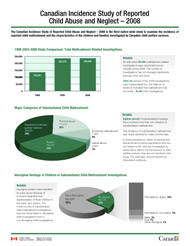ARCHIVED - Canadian Incidence Study of Reported Child Abuse and Neglect 2008
For readers interested in the full version of this report, the document is available for downloading or viewing:
Canadian Incidence Study of Reported Child Abuse and Neglect 2008
The Canadian Incidence Study of Reported Child Abuse and Neglect - 2008 is the third nation-wide study to examine the incidence of reported child maltreatment and the characteristics of the children and families investigated by Canadian child welfare services.
1998-2003-2008 Study Comparison: Total Maltreatment-Related Investigations

Notable
An estimated 235,842 maltreatment-related investigations were conducted across Canada during 2008. The number of investigations has not changed significantly between 2003 and 2008.
Thirty-six percent of the 2008 investigations were substantiated (i.e., the balance of evidence indicated that maltreatment had occurred) - 85,440 child investigations.
Major Categories of Substantiated Child Maltreatment

Notable
Eighteen percent of substantiated investigations involved more than one category of substantiated maltreatment.
The incidence of substantiated maltreatment was nearly identical for males and females.
In some jurisdictions, cases of physical and sexual abuse involving perpetrators who are not related to the child are investigated by police alone without the involvement of child welfare workers; they are not reported in this study. The estimates should therefore be interpreted cautiously.
Aboriginal Heritage of Children in Substantiated Child Maltreatment Investigations

Notable
Aboriginal children were identified as a key group because of concerns regarding over-representation of these children in the foster care system. The incidence rate of substantiated child maltreatment investigations was four times higher in Aboriginal child investigations than in non-Aboriginal child investigations.
Select Child Functioning Issues in Substantiated Child Maltreatment Investigations

[Accessible Version]
Child functioning across physical, emotional, cognitive, and behavioural domains was documented with a checklist of 18 issues that child welfare workers were likely to be aware of as a result of their investigation. Because the checklist documents only issues that child welfare workers became aware of during their investigation, the occurrence of these issues may have been underestimated. The six-month period before the investigation was used as a reference point. For additional information, refer to pages 4, 36 and 38 of the Canadian Incidence Study of Reported Child Abuse and Neglect - 2008: Major Findings.
In an estimated 46% of substantiated child maltreatment investigations (or 39,460), at least one child functioning issue was indicated. Figure 9 The figure displays the six most frequently reported child functioning issues: academic difficulties (23%), depression/anxiety/withdrawal (19%), child aggression (15%), attachment issues (14%), Attention Deficit Disorder (ADD) or Attention Deficit Hyperactivity Disorder (ADHD) (11%), and developmental disabilities (11%).
[ back ]
Primary Caregiver Risk Factors in Substantiated Child Maltreatment Investigations

[Accessible Version]
Child welfare workers completed a checklist of potential caregiver stressors that they had noted during the investigation. In an estimated 78% of substantiated child maltreatment investigations (or 66,282), at least one caregiver risk factor was reported. The most frequently noted concerns were being a victim of domestic violence (46%), having few social supports (39%), and having mental health issues (27%). For additional information, refer to pages 40-41 of the of the Canadian Incidence Study of Reported Child Abuse and Neglect - 2008: Major Findings.
[ back ]
Select Household Risk Factors in Substantiated Child Maltreatment Investigations

[Accessible Version]
The CIS-2008 tracked a number of household risk factors including social assistance, household moves in 12 months, and household hazards. Household hazards included access to drugs or drug paraphernalia, unhealthy or unsafe living conditions and accessible weapons.
An estimated 33% of substantiated investigations involved families receiving social assistance or other benefits as their source of income. Twenty percent involved families that had moved once in the previous year. In 12% of the investigations, at least one household hazard was noted. For additional information, refer to pages 41-43 of the Canadian Incidence Study of Reported Child Abuse and Neglect - 2008: Major Findings.
[ back ]
Reference: Public Health Agency of Canada. Canadian Incidence Study of Reported Child Abuse and Neglect - 2008: Major Findings. Ottawa, 2010.
For Further Information: Visit www.phac-aspc.gc.ca/cm-vee/public-eng.php or call the Injury and Child Maltreatment Section at (613) 957-4689.
